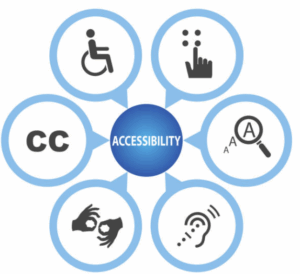Creating a More Equitable World
In today’s world, designing spaces, products, and digital experiences that work for everyone is no longer optional, it’s essential. Accessibility, inclusive design, and universal design are key approaches that ensure individuals of all abilities can fully participate in society. While these terms are often used interchangeably, each has distinct principles and applications. Let’s explore their meanings and why they matter.
What Is Accessibility?
Accessibility refers to the removal of barriers that prevent people with disabilities from accessing and using physical and digital environments. It ensures that individuals, regardless of physical, sensory, or cognitive limitations, can navigate and engage with the world effectively.
Accessibility is often governed by standards and regulations, such as the Americans with Disabilities Act (ADA) and Web Content Accessibility Guidelines (WCAG). These frameworks set expectations for accessible design across buildings, transportation systems, websites, and digital interfaces.
However, accessibility shouldn’t be seen as merely a legal requirement—it benefits everyone. For example:
- Curb cuts, originally designed for wheelchair users, also help parents with strollers and workers with carts.
- Closed captions, essential for people who are deaf or hard of hearing, are widely used in noisy environments or by language learners.
What Is Inclusive Design?
Inclusive design focuses on designing experiences that accommodate the widest range of people possible. Unlike accessibility, which often involves adapting existing designs, inclusive design starts from the beginning with diverse needs in mind.
Inclusive design acknowledges that people experience the world in different ways based on factors like age, ability, culture, language, and socioeconomic status. It emphasizes flexibility and adaptability rather than a “one-size-fits-all” approach.
A great example of inclusive design is:
- Adjustable-height desks, which benefit individuals of varying heights, wheelchair users, and those who prefer standing while working.
What Is Universal Design?
Universal design takes inclusivity even further by striving for designs that work for everyone without the need for adaptations or specialized solutions. Developed as an architectural concept, universal design principles apply to education, technology, public spaces, and everyday products.
The seven principles of universal design guide this approach:
- Equitable Use – The design is usable by people with diverse abilities.
- Flexibility in Use – It accommodates a wide range of preferences.
- Simple and Intuitive Use – It’s easy to understand regardless of experience or ability.
- Perceptible Information – It effectively communicates necessary information.
- Tolerance for Error – It minimizes hazards and unintended actions.
- Low Physical Effort – It can be used efficiently and comfortably.
- Size and Space for Approach and Use – It provides adequate space regardless of mobility needs.
Examples of universal design include:
- Automatic doors, which benefit wheelchair users, parents with strollers, and individuals carrying heavy objects.
- Voice-controlled technology, useful for people with disabilities, but also convenient for multitasking.
Rather than seeing accessibility, inclusive design, and universal design as separate concepts, they work together to create environments that embrace diversity. Designing for everyone not only enhances user experiences but also fosters equity and dignity in society.
By integrating these principles into our daily lives, whether in architecture, education, technology, or policy, we move toward a world where people of all abilities can fully participate.
Good design isn’t just about aesthetics, it’s about functionality, usability, and inclusivity. When we prioritize accessibility, inclusive design, and universal design, we create a world that benefits everyone.
Let’s make inclusivity the standard, not the exception.
Source: Read MoreÂ




